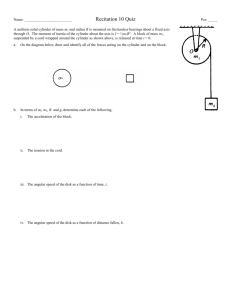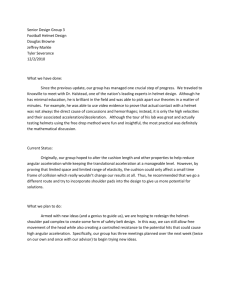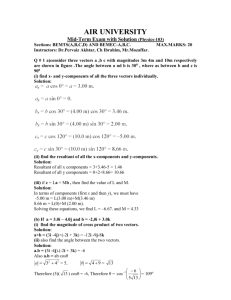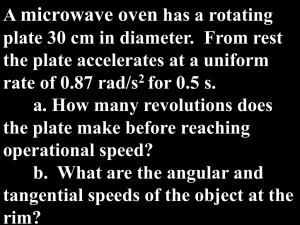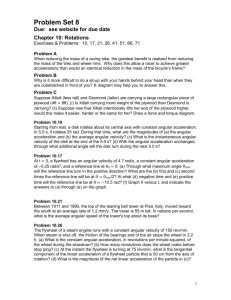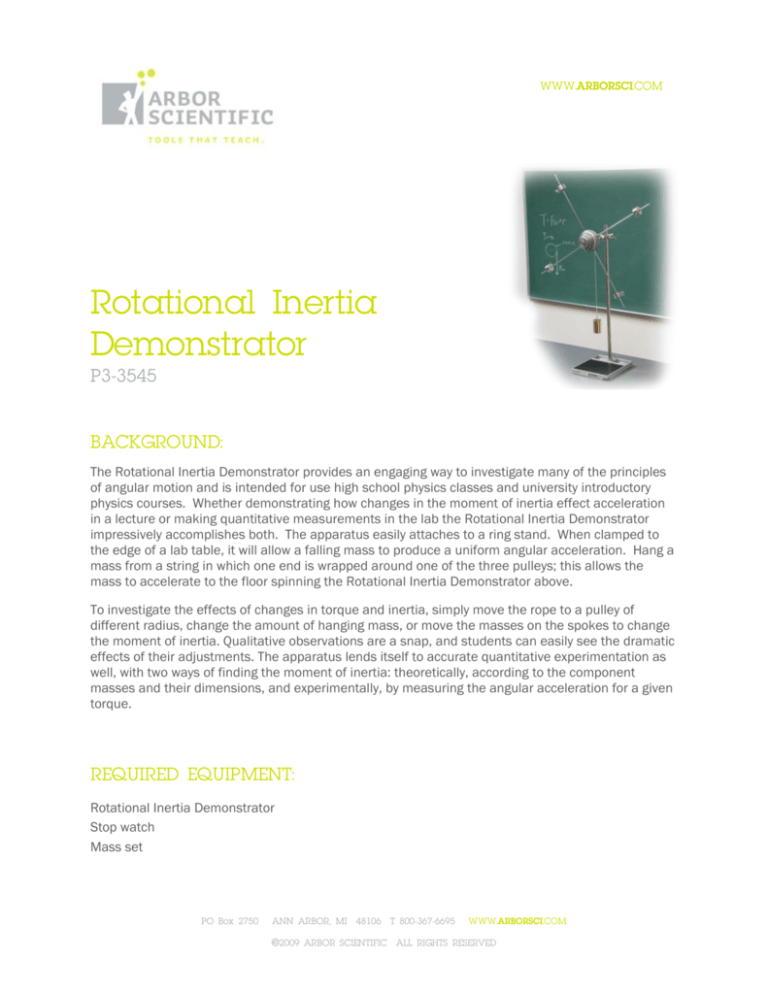
WWW.ARBORSCI.COM
Rotational Inertia
Demonstrator
P3-3545
BACKGROUND:
The Rotational Inertia Demonstrator provides an engaging way to investigate many of the principles
of angular motion and is intended for use high school physics classes and university introductory
physics courses. Whether demonstrating how changes in the moment of inertia effect acceleration
in a lecture or making quantitative measurements in the lab the Rotational Inertia Demonstrator
impressively accomplishes both. The apparatus easily attaches to a ring stand. When clamped to
the edge of a lab table, it will allow a falling mass to produce a uniform angular acceleration. Hang a
mass from a string in which one end is wrapped around one of the three pulleys; this allows the
mass to accelerate to the floor spinning the Rotational Inertia Demonstrator above.
To investigate the effects of changes in torque and inertia, simply move the rope to a pulley of
different radius, change the amount of hanging mass, or move the masses on the spokes to change
the moment of inertia. Qualitative observations are a snap, and students can easily see the dramatic
effects of their adjustments. The apparatus lends itself to accurate quantitative experimentation as
well, with two ways of finding the moment of inertia: theoretically, according to the component
masses and their dimensions, and experimentally, by measuring the angular acceleration for a given
torque.
REQUIRED EQUIPMENT:
Rotational Inertia Demonstrator
Stop watch
Mass set
PO Box 2750
ANN ARBOR, MI 48106 T 800-367-6695
WWW.ARBORSCI.COM
©2009 ARBOR SCIENTIFIC ALL RIGHTS RESERVED
EXPERIMENTS IN ROTATIONAL MOTION:
In three experiments you will study kinematics and dynamics of
rotational motion using the Rotational Inertia Demonstrator. In the
first experiment, angular acceleration will be determined by two
methods and their values compared. Likewise, in the second
experiment, comparisons of the calculated value of the moment of
inertia by two methods will be made. In the final experiment you will
apply the law of conservation of energy. Since there is very little
friction, a good approximation of the conservation of mechanical
energy can be obtained.
INSTRUCTIONS FOR ASSEMBLY:
When you receive your Rotation Inertia demonstrator, you will need to assembly the radial arms and
the pulley gear. Apply a few turns of the Teflon Tape supplied with your unit. Wrap to Teflon Tape
clockwise around the threads and then tighten securely in the pulley gear’s radial arm screw sockets.
The Teflon Tape will allow for a snug fit of the rods coarse threads in the socket and prevents
unwanted vibrations during precision rotation experiments.
PO Box 2750
ANN ARBOR, MI 48106 T 800-367-6695
WWW.ARBORSCI.COM
©2009 ARBOR SCIENTIFIC ALL RIGHTS RESERVED
TEACHER NOTES:
EXPERIMENT #1 KINEMATICS OF ROTATIONAL MOTION
(Method 1) Calculating the Angular acceleration form the total time and the angular displacement
(θ); using the equation [θ = ωi t + ½ αt2] where ωi= 0:
Start by hanging a mass from a string in which one end is wrapped around one of the three pulleys.
Rotate the apparatus allowing the mass to descend until it just touches the floor. Now raise the
mass by winding up apparatus until it has rotated a complete number times (4 to 6 times). When
released the allowing the falling mass will accelerate the apparatus resulting in an angular
displacement equal to the number of rotations used to raise the mass. This angular displacement
(θ) can be found by multiplying the number of rotations by 2 π.
In the sample calculation below apparatus was rotated five complete times. This gives an angular
displacement of 31.4 radians.
Finding the angular acceleration of the falling mass:
Equation: Calculating (α) α = 2 θ/t2
Substitution: α = 2(31.4)/(8.04)2
Answer α = _____0.972 rad/s2
(Method 2) In the second method, angular acceleration is determined from the linear acceleration
and the radius of the pulley.
Finding the linear acceleration of the falling mass:
Vertical displacement ‘s’ = ___.923________ m
Equation: Calculating (a) a = 2s/t2
Substitution: a = 2(.923)/(8.04)2 = 0.0286 m/s2
Answer a = ___0.0309 m/s2
PO Box 2750
ANN ARBOR, MI 48106 T 800-367-6695
WWW.ARBORSCI.COM
©2009 ARBOR SCIENTIFIC ALL RIGHTS RESERVED
Transforming linear acceleration into angular acceleration:
Pulley radius ___0.0293___ m
Answer α = a/r = .0286/.0293 = 0.975 rad/s2
Substitution: a = 2(.923)/(8.04)2 = 0.0286 m/s2
As can be seen from the sample data, close agreement between the two methods is expected.
Answer a = #2
___0.0309
m/s2 THE MOMENT OF INERTIA
EXPERIMENT
DETERMINING
FT
(Method 1) In this experiment the rotational inertia ‘I’ of the apparatus is
found by applying Newton’s second law for rotational motion: ( = I α). Here
the torque ‘’ is produced by the tension in the string ‘FT’. To calculate this
tension, the mass of the falling weight and its vertical acceleration from
experiment 1 is needed. Using the equation FW - FT = ma the value (FT) can
be determined.
FW
FT = FW – ma = (.20)(9.81) – (.20)(.0309) = 1.956 N
Combining the value of (a) the tension in the string ‘FT’, (b) the radius of pulley ‘r’ and (c) the angular
acceleration of the apparatus ‘α’ from above, we can solve for ‘I’ the moment of inertia using ( = I
α), where = FT x r
Equation: Calculating (I) I = FT x r/ α
Substitution: I = (1.956 N)(0.0395 m)/ (0.783 rad/s2)
Answer I = _.0988 kg m2
(Method 2) Direct Determination of Moment of Inertia from formulas. When adding up the moment
of inertia of each of the parts of the apparatus, the value of the pulley component of the apparatus
cannot be easily determined. This value is therefore provided for the students and is given to be
(.00058 kg m2). Sample data is given below based on the moveable masses being placed at the far
end of the rods.
PO Box 2750
ANN ARBOR, MI 48106 T 800-367-6695
WWW.ARBORSCI.COM
©2009 ARBOR SCIENTIFIC ALL RIGHTS RESERVED
I(pulleys) __________.00058 ____________ kg m2 (provided by teacher)
Thin Rods: length _________ m,
mass _____________ kg
I( thin rods) __________ kg m2 (times four) ____0.0127___ kg m2
Movable mass: mass _______ kg
distance from center ______ m
I ( movable mass) ________________ (times four) ____0.0834___ kg m2
Σ I = I (pulleys) + I (rods) + I ( movable masses) = ___.0968_ kg m2
EXPERIMENT #3 ENERGY OF ROTATIONAL MOTION
Using the equations for translational and rotational kinetic energy and comparing their total to the
loss of potential energy of the system, a good approximation of the conservation of mechanical
energy can be found. KE(total) = ½ mv2 + ½ Iω2
I
(kg m2)
ωf
(rad/s)
KE(rot)
( J)
KE(tran)
(J)
KE (total)
(J)
ΔPE
(J)
0.097
6.376
1.959
0.00344
1.976
1.962
Above is the result of sample calculations from the lab representing good confirmation of the
conservation of mechanical energy.
PO Box 2750
ANN ARBOR, MI 48106 T 800-367-6695
WWW.ARBORSCI.COM
©2009 ARBOR SCIENTIFIC ALL RIGHTS RESERVED
STUDENT LABS:
EXPERIMENT #1 KINEMATICS OF ROTATIONAL MOTION
As any object starts spinning faster and faster it is experiencing a type of acceleration called angular
acceleration (α). In this experiment with the Rotational Inertia Demonstrator you will calculate this
acceleration using two different methods and compare their results.
Procedure:
(Method 1) Calculating angular acceleration (α) using [θ = ωi t + ½ αt2] where ωi= 0:
1. Start by hanging a mass from a string in which one end is wrapped around one of the three
pulleys. Rotate the apparatus allowing the mass to descend until it just touches the floor.
Now raise the mass by winding up apparatus until it has rotated a complete number of times
(4 to 6 times). Measure the vertical distance the hanging mass was raised above the floor ‘s’
and record this distance in the space provided in method 2. When released, the falling mass
will accelerate the apparatus resulting in an angular displacement equal to the number of
rotations used to raise the mass. This angular displacement (θ) can be found by multiplying
the number of rotations by 2 π.
# Rotations ____________________ = _____________________ radians
# Rotations
____________________
= _____________________ radians
Timing
the free
fall:
2. Start with the all moveable masses on the rods placed at the same distance from the center.
Raise the hanging mass back up to its initial distance above the floor and time its fall to the
floor as
it freely accelerates the= apparatus
rest. Repeat thisradians
process of measuring the time
# Rotations
____________________
_____________________
to fall, until you have at least three consistent values. Average these three values.
(t1) __________ s (t2) __________ s (t3) __________ s
(tavg) __________ s
Calculating the Angular acceleration:
3. To calculate this acceleration you will use three different values from your experiment. First,
since the falling weight and the apparatus were initially at rest, the starting angular velocity
was zero (ωi). Second, the total angular displacement in radians (θ) was determined from
the number of rotations the apparatus made.
Knowing the average time of acceleration, the angular displacement and the initial angular
velocity, calculate the average angular acceleration.
PO Box 2750
ANN ARBOR, MI 48106 T 800-367-6695
WWW.ARBORSCI.COM
©2009 ARBOR SCIENTIFIC ALL RIGHTS RESERVED
Finding the angular acceleration of the falling mass:
Equation: Calculating (α) α =
Substitution: α =
Answer α = ___________ rad/s2
(Method 2) calculating angular acceleration using (a = αr)
4. First, calculate the linear acceleration (a) of the falling mass from the data above. Use the
vertical displacement (s), time to fall and the initial velocity (vi) of the mass, which was zero,
to make this calculation.
Vertical displacement ‘s’ = ___________ m
Equation: Calculating (a) a =
Substitution: a =
Answer a = ________________ m/s2
5. Determine the radius of the pulley, which the string is wrapped around, by measuring its
diameter with a caliper of ruler. Points on the pulley at the radius where the string is
unwinding, experience a tangential acceleration (aT), which is the same as the linear
acceleration of the falling mass.
Pulley radius _____________ m
6. Use the relationship between the angular acceleration (α) of a rotating object and the
tangential acceleration (aT) of a point on the object at a given radius (r), to determine the
angular acceleration of the apparatus.
Equation: α =
Answer α = ________________ rad/s2
7. Compare the two acceleration values and determine if they agree within the uncertainty of
measurement.
PO Box 2750
ANN ARBOR, MI 48106 T 800-367-6695
WWW.ARBORSCI.COM
©2009 ARBOR SCIENTIFIC ALL RIGHTS RESERVED
EXPERIMENT #2 DETERMINING THE MOMENT OF INERTIA OF THE ROTATIONAL INERTIA
DEMONSTRATOR
When an unbalanced torque is applied to a body it will experience an angular acceleration in accord
with Newton’s second law. Here the net force becomes the net torque, and mass becomes the
moment of inertia. Calculating the angular acceleration as in experiment 1 and using the torque
produce by the tension in the string connected to the falling mass, you will calculate apparatus’s
moment of inertia. Next, you will calculate the moment of inertia a second time by the direct
application of the formulas for the moment of inertia of geometric objects.
Procedure:
(Method 1) Using Newton’s 2nd Law
1. This method will require you to use the calculated values from experiment 1 for both the
vertical acceleration of the falling mass and the angular acceleration of the rotating
apparatus. In addition, you will need to use the same value of the falling mass and the
radius of the pulley used in the experiment. Record these acceleration values below.
Angular acceleration of rotating apparatus (Exp.1, Method 1) ______________ rad/s2
Linear Acceleration of falling mass (Exp.1, Method 2) ______________ m/s2
2. Below you will calculate the torque produced by the string attached to the falling mass. This
value is a product of the tension (FT) in the string and the radius of the pulley you chose to
wrap the string around. Record the radius of the pulley used in experiment 1.
Radius of pulley __________ m
3. To calculate the tension in the string, use the value of the linear acceleration of the falling
mass and its weight. Here, the tension of the string pulling down on the side of the pulley is
the same tension pulling up on the falling mass. What two forces are acting on the falling
mass and which is greater? Draw a free body diagram of these forces and use Newton’s
second law to calculate the string tension.
Falling mass (m)________________ kg
Weight of falling mass (FW)____________ N
Equation: Calculating (FT) FT =
Substitution: FT =
Answer FT = _____________ N
PO Box 2750
ANN ARBOR, MI 48106 T 800-367-6695
WWW.ARBORSCI.COM
©2009 ARBOR SCIENTIFIC ALL RIGHTS RESERVED
4. Now that you have the value of (a) the tension in the string, (b) the radius of pulley and (c)
the angular acceleration of the apparatus, solve for ‘I’ the moment of inertia using Newton’s
Law
( = I α).
Equation: Calculating (I) I =
Substitution: I =
Answer I = ________________ kg m2
(Method 2) Direct Determination of Rotational Inertia from formulas
The direct method requires you to find the total moment of inertia by adding up the moment of
inertia of each of the parts of the apparatus. To do this, your will need to know the masses and
dimensions of the various parts of the system. Since all the thin rods and moveable masses are the
same you only need to measure one of each. The moveable masses on the rods are treated as
point-masses and have the same formula for moment of inertia as a hoop. Unscrew one of the thin
rods and find and record its mass. For its length, use the distance from the center of the axis of
rotation to its end point. Even though this ignores the short distance near the center, you will still
have a good approximation. Finally, the pulleys assembly can be treated as and series of disks,
however, since these cannot be individually measured, the moment of inertia of the pulley assembly
will be provided by the lab instructor. Remember, that the moment of inertial of a system is just the
sum of the moments of inertia of the individual parts.
I(pulleys) ________________________ kg m2 (provided by teacher)
Thin Rods: length _________ m,
mass _____________ kg
I( thin rods) __________ kg m2 (times four) _______________ kg m2
Movable mass: mass _______ kg
distance from center ______ m
I ( movable mass) ________________ (times four) _______________ kg m2
Σ I = I (pulleys) + I (rods) + I ( movable masses)
Σ I = ___________ + _____________ + _____________ = ____________ kg m2
Compare the moment of inertia values from methods 1 & 2 and determine if they agree within the
uncertainty of measurement.
PO Box 2750
ANN ARBOR, MI 48106 T 800-367-6695
WWW.ARBORSCI.COM
©2009 ARBOR SCIENTIFIC ALL RIGHTS RESERVED
EXPERIMENT 3 ENERGY OF ROTATIONAL MOTION
Like the energy that runs a Grandfather clock, the Rotational Inertia Demonstrator is powered by the
potential energy of a falling weight. With friction extremely small, the transfer of energy within the
system represents a good approximation of the conservation of mechanical energy. As the falling
hanging mass loses gravitational potential energy, it and the rotating apparatus above gain kinetic
energy. The purpose of this activity is to calculate and compare the final kinetic energy of the system
to the loss of potential energy of the falling mass.
Determining the initial mechanical energy of the system.
1. With the apparatus initially at rest and the hanging mass raised above the floor, the total
mechanical energy of the system equals the potential energy of the hanging mass. Measure
and record its mass and height through which is will fall.
Gravitational Potential Energy
Falling mass:
Mass __________ kg
Vertical displacement ___________ m
Equation: Calculating (Potential Energy PE) PE =
Substitution: PE =
Answer PE = _____________ J
Translational Kinetic Energy
2. To find the kinetic energy of the falling mass as it strikes the floor, you will need to know its
final velocity. As in experiment 1, raise the falling mass to its initial position and time its
descent to the floor, repeating this until you have three consistent values. Record their
average.
(t1) ________ s (t2) ________ s (t3) ________ s
(tavg) ________ s (vavg) __________m/s
3. Next, use the vertical displacement (s), the average time to fall and the initial velocity (vi) of
the mass (which was zero), to calculate the average velocity with which the mass strikes the
floor. From the mean speed equation we know that velocity final is two times the average
velocity. With this value, continue and calculate the falling mass’s kinetic energy as it
reaches the floor.
Vf = 2 x Vavg
=
PO Box 2750
ANN ARBOR, MI 48106 T 800-367-6695
WWW.ARBORSCI.COM
©2009 ARBOR SCIENTIFIC ALL RIGHTS RESERVED
Equation: Calculating Kinetic Energy KE =
Substitution: KE =
Answer KE f = ________________ J
Rotational Kinetic Energy
4. The equation for rotational kinetic energy has the same format as translational kinetic
energy. In the rotational equation, the mass is replaced with its moment of inertia (I) and the
final velocity is replaced with its final angular velocity (ωf). . Use the value for the moment of
inertia you calculated in experiment 2. Vf for the falling mass is the same tangential velocity
of the pulley with the string wrapped around. From the equation (v = r ω ), the value of ωf will
be calculated by dividing above Vf for the falling mass by the radius of the pulley.
Radius of pulley _________ m
ωf = __________________ rad /s I = ____________ kg m2
Equation: Calculating Rotational Kinetic Energy KE =
Substitution: KE =
Answer KE = ________________ J
KE(total) = _______________(tran.) + ________________ (rot.) = _______________ J
5. Compare below the sum of the two final kinetic energies to the loss of potential energy of the
falling mass and determine if they agree within the uncertainty of measurement.
PO Box 2750
ANN ARBOR, MI 48106 T 800-367-6695
WWW.ARBORSCI.COM
©2009 ARBOR SCIENTIFIC ALL RIGHTS RESERVED

